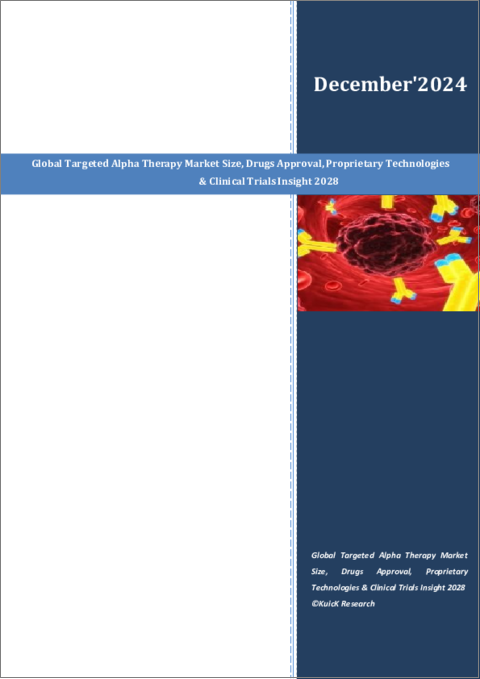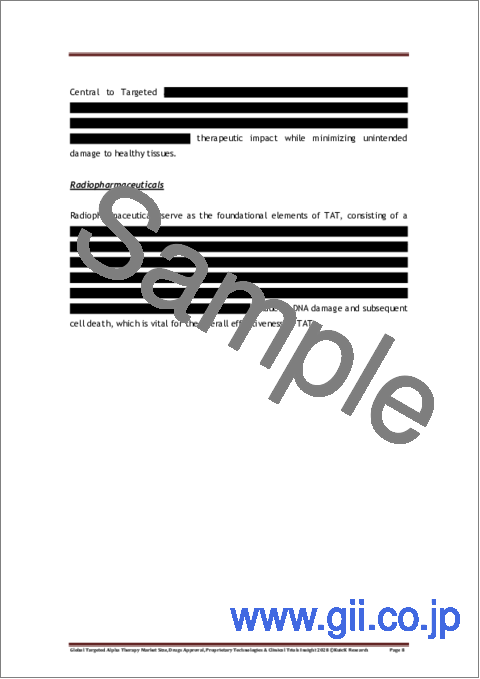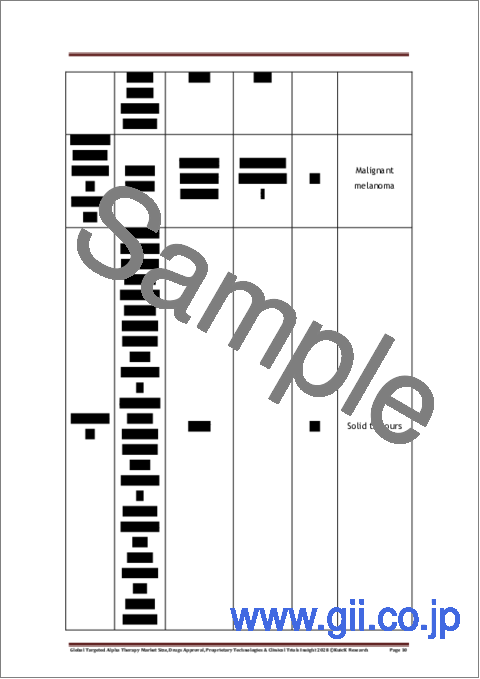|
|
市場調査レポート
商品コード
1609389
標的アルファ線治療の世界市場:市場規模、薬剤承認、独自技術、臨床試験に関する洞察(2028年)Global Targeted Alpha Therapy Market Size, Drugs Approval, Proprietary Technologies & Clinical Trials Insight 2028 |
||||||
|
|||||||
| 標的アルファ線治療の世界市場:市場規模、薬剤承認、独自技術、臨床試験に関する洞察(2028年) |
|
出版日: 2024年12月01日
発行: KuicK Research
ページ情報: 英文 90 Pages
納期: 即日から翌営業日
|
全表示
- 概要
- 図表
- 目次
放射性免疫療法は、放射性同位元素を利用して疾患組織を特異的に狙い撃ちし、除去するという、現代医学における顕著な進歩を示すものです。伝統的に、ベータおよびガンマ線放出核種は、がん、甲状腺疾患、特定の神経疾患の治療など、様々な治療用途で広く使用されてきました。ベータ粒子は、その適度な透過能力が認められ、細胞の悪性腫瘍に対処する上で重要な役割を果たしてきました。一方、ガンマ線は、組織により深く透過するため、イメージングと治療介入の両方に頻繁に使用されています。しかしながら、これらの放射線はその有効性にもかかわらず、隣接する健康な組織への潜在的な損傷や、正確な局所効果を得ることの難しさなど、ある種の欠点を伴っています。
アルファ線放出核種の導入は、放射性医薬品の分野を一変させました。これらの粒子は、高い線エネルギー付与(LET)と非常に限定された透過深度によって区別され、周囲の健康な組織を温存しながら、がん細胞を排除する際に卓越した精度を発揮します。この特性により、アルファ線放出粒子は微小転移性疾患や孤立した悪性細胞を標的とする場合に特に有利であり、従来のベータ線やガンマ線による治療法よりも大幅に改善されます。
標的アルファ線治療(TAT)の領域における重要な成果は、Xofigo(ラジウム223ジクロリド)の承認です。このアルファ線を放出する放射性医薬品は、内臓転移のない症候性骨転移を示す去勢抵抗性前立腺がん(CRPC)患者の治療薬として承認されました。この承認は、主要な第3相ALSYMPCA試験に基づくもので、患者の生存率および疼痛緩和において大きな優位性を示し、進行期前立腺がんの疼痛管理における新たな基準を確立しました。現在、Xofigoは50カ国以上で承認されており、世界の臨床的・商業的成功を裏付けています。
Xofigoは現在、承認された唯一のアルファ線放出療法ですが、アルファ線標的療法の分野は、特に固形がんを対象として急速な成長を遂げています。治療効果を向上させ、治療用途を拡大するために、研究者たちはさまざまなアルファ線放出物質を熱心に研究しています。その中で、Lead-212は特に有望な選択肢として浮上しており、多くの前臨床試験や臨床試験で可能性を示しています。さらに、ユタ大学の最近の研究では、アルツハイマー病などの神経変性疾患の治療における標的アルファ線治療の有効性が評価されています。これは、複雑な医学的問題に幅広く取り組むアルファ線放出装置の適応性と広範な可能性を示しています。
TATへの関心は既存企業だけにとどまらず、新規参入企業が新たなメカニズムを導入し、アルファ線放出療法の種類を増やすことで競合環境を一変させています。このような技術革新の高まりは、パートナーシップ、投資、共同研究イニシアティブを促進し、さらなる臨床的・商業的進歩への勢いを生み出しています。市場が進展するにつれて、精密医療におけるアルファ線放出装置の重要性が高まり、さまざまな疾患に対してより効果的で侵襲の少ない治療オプションが楽観視できるようになると予想されます。標的アルファ線治療の可能性により、放射性医薬品の将来は、現代医療における喫緊の課題のいくつかに取り組むのに十分な位置にあると思われます。
当レポートは、世界の標的アルファ線治療市場について調査し、市場の概要とともに、薬剤動向、臨床試験動向、地域別動向、および市場に参入する企業の競合情勢などを提供しています。
目次
第1章 標的アルファ線治療のイントロダクション
第2章 標的アルファ線治療- 構造と作用機序
- 構造
- 作用機序
第3章 標的アルファ線治療の応用、がん別
- 造血悪性腫瘍
- 固形腫瘍
第4章 世界の標的アルファ線治療市場の洞察
- 現在の市場シナリオ
- 将来の成長の道
第5章 標的アルファ線治療市場の洞察、地域別
- 米国
- 欧州
- 中国
- 日本
- オーストラリア
第6章 標的アルファ線治療の臨床試験に関する企業、国、適応症、相別の考察
- 研究
- 前臨床
- 第I相
- 第I/II相
- 第II相
- 第II/III相
- 第III相
第7章 企業、国、適応症別に見た市販の標的アルファ線治療の臨床的洞察
第8章 Xofigo- 最初に承認された標的アルファ線治療
第9章 標的アルファ線治療- 企業独自の技術プラットフォーム
第10章 世界の標的アルファ線治療市場力学
- 促進要因と機会
- 課題と抑制要因
第11章 競合情勢
- Actinium Pharma
- AdvanCell
- Bayer
- Fusion Pharma
- Johnson & Johnson
- Modulation Therapeutics
- Orano Med
- Perspective Therapeutics
- RayzeBio
- Telix Pharmaceuticals
List of Figures
- Figure 2-1: Targeted Alpha Therapy - Structure
- Figure 2-2: Targeted Alpha Therapy - Mechanism Of Action
- Figure 3-1: LIN-AC225-AML02 Phase 1/2 (NCT03867682) Study - Initiation & Completion Year
- Figure 3-2: AcTRESS Phase 1 (NCT06411301) Study - Initiation & Completion Year
- Figure 3-3: RG1121028 Phase 1 (NCT04579523) Study - Initiation & Completion Year
- Figure 3-4: 225Ac-DOTA-daratumumab Phase 1 (NCT05363111) Study - Initiation & Completion Year
- Figure 3-5: PAnTHA Phase 1 (NCT06217822) Study - Initiation & Completion Year
- Figure 3-6: PSMA-617-100 Phase 1 (NCT04597411) Study - Initiation & Completion Year
- Figure 3-7: BAY3546828 Phase 1 (NCT06052306) Study - Initiation & Completion Year
- Figure 3-8: VMT-a-NET-T101 Phase 1/2a (NCT05636618) Study - Initiation & Completion Year
- Figure 3-9: FPI-2059-101 Phase 1 (NCT05605522) Study - Initiation & Completion Year
- Figure 4-1: Factors Influencing Future Market of Targeted Alpha Therapies
- Figure 4-2: Global - Targeted Alpha Therapy Market Opportunity (US$ Million), 2025 & 2028
- Figure 9-1: Fusion Pharma - Fast-Clear(TM) Linker Technology
- Figure 9-2: AdvanCell - Proprietary 212Pb Production Technology
- Figure 9-3: Cellectar Biosciences - Phospholipid Ether (PLE) Platform Technology
- Figure 9-4: Perspective Therapeutics - Proprietary Technology & Pb-212 Isotope
Generator VMT-a-NET
- Figure 10-1: Global Targeted Alpha Therapy Market - Drivers & Opportunities
- Figure 10-2: Global Targeted Alpha Therapy Market - Challenges & Restraints
List of Tables
Table 1 1: Alpha Radiation vs. Beta & Gamma Radiation In Cancer Therapy
- Table 4-1: Efforts to Increase Radioisotope Production Capacity
- Table 4-2: Recent Collaborations for Targeted Alpha Therapy Development
- Table 6-1: Targeted Alpha Therapies In Research Stage, 2024
- Table 6-2: Targeted Alpha Therapies In Preclinical Stage, 2024
- Table 6-3: Targeted Alpha Therapies In Phase I, 2024
- Table 6-4: Targeted Alpha Therapies In Phase I/II, 2024
- Table 6-5: Targeted Alpha Therapies In Phase II, 2024
- Table 6-6: Targeted Alpha Therapies In Phase II/III, 2024
- Table 6-7: Targeted Alpha Therapies In Phase III, 2024
- Table 7-1: Marketed Targeted Alpha Therapies, 2024
- Table 8-1: Xofigo - Decay Correction Factor
Global Targeted Alpha Therapy Market Size, Drugs Approval, Proprietary Technologies & Clinical Trials Insight 2028 Report Highlights:
- Global Targeted Alpha Therapy Market Insight By Region
- Approved Targeted Alpha Therapy Dosage & Pricing Insight
- Number Of Targeted Alpha Therapy In Clinical Trials: > 20 Drugs
- Targeted Alpha Therapy Clinical Trials Insight By Company, Country, Indication & Phase
- Marketed Targeted Alpha Therapy Clinical Insight By Company, Country & Indication
- Targeted Alpha Therapy Proprietary Technology Platform Insights By Company
Radioimmunotherapy marks a notable progression in modern medicine, utilizing radioactive isotopes to specifically target and eliminate diseased tissues. Traditionally, beta and gamma emitters have been extensively employed across various therapeutic applications, such as in the treatment of cancer, thyroid disorders, and certain neurological ailments. Beta particles, recognized for their moderate penetration capabilities, have played a crucial role in addressing cellular malignancies, whereas gamma rays, which penetrate deeper into tissues, are frequently used for both imaging and therapeutic interventions. Nonetheless, despite their effectiveness, these radiation types are accompanied by certain drawbacks, including potential damage to adjacent healthy tissues and difficulties in achieving precise localized effects.
The introduction of alpha emitters has transformed the field of radiopharmaceuticals. These particles, distinguished by their high linear energy transfer (LET) and very limited penetration depths, provide exceptional accuracy in eliminating cancer cells while preserving surrounding healthy tissues. This characteristic renders alpha emitters particularly advantageous for targeting micrometastatic diseases and isolated malignant cells, offering a significant improvement over conventional beta and gamma therapies.
A significant achievement in the realm of targeted alpha therapy (TAT) is the approval of Xofigo (radium-223 dichloride). This alpha-emitting radiopharmaceutical has been approved for the treatment of patients with castration-resistant prostate cancer (CRPC) who exhibit symptomatic bone metastases without known visceral metastases. Its approval, based on the pivotal Phase 3 ALSYMPCA trial, demonstrated considerable survival advantages and pain alleviation for patients, establishing a new benchmark for the management of advanced-stage prostate cancer. Presently, Xofigo holds approval in over 50 countries, underscoring its global clinical and commercial success.
While Xofigo currently stands as the sole approved alpha emitting therapy, the field of targeted alpha therapy is experiencing rapid growth, particularly for solid tumors. Researchers are diligently exploring various alpha emitters to improve treatment effectiveness and expand therapeutic applications. Among these, Lead-212 has emerged as a notably promising option, demonstrating potential in numerous preclinical and clinical investigations. Additionally, researchers are examining uses beyond oncology, highlighted by a recent study from the University of Utah that assessed the efficacy of targeted alpha therapies in treating neurodegenerative diseases such as Alzheimer's. This illustrates the adaptability and extensive potential of alpha emitters in tackling a wide range of complex medical issues.
The landscape of clinical trials for TAT is both dynamic and competitive. Companies such as RayzeBio are at the forefront, with their candidate RYZ101 progressing to Phase 3 trials for patients with somatostatin receptor-positive gastroenteropancreatic neuroendocrine tumors. These tumors, which have advanced following previous Lutetium-177-based treatments, represent a significant unmet medical need. The advancement of RYZ101 highlights the increasing emphasis on alpha emitters as viable alternatives to current radiopharmaceuticals. Furthermore, the market has seen a surge of innovative preclinical candidates. In January 2024, Cellectar Biosciences reported promising preclinical results for CLR 121225, an alpha-emitting phospholipid radiotherapeutic conjugate aimed at pancreatic cancer. This development signifies a continued dedication to innovation and the potential for broadening TAT applications into previously unexplored areas.
Interest in TAT is not limited to established companies; new entrants are transforming the competitive environment by introducing novel mechanisms and expanding the array of alpha-emitting therapies. This surge of innovation is fostering partnerships, investments, and collaborative research initiatives, thereby generating momentum for additional clinical and commercial advancements. As the market progresses, the significance of alpha emitters in precision medicine is expected to increase, providing optimism for more effective and less invasive treatment options for a wide range of diseases. With the potential of targeted alpha therapy, the future of radiopharmaceuticals appears well-positioned to tackle some of the most urgent challenges in contemporary medicine.
Table of Contents
1. Introduction To Targeted Alpha Therapy
- 1.1 Overview
- 1.2 Alpha Radiation vs. Beta & Gamma Radiation In Cancer Therapy
2. Targeted Alpha Therapy - Structure & Mechanism Of Action
- 2.1 Structure
- 2.2 Mechanism Of Action
3. Targeted Alpha Therapy Applications By Cancer
- 3.1 Hematological Malignancies
- 3.2 Solid Tumors
4. Global Targeted Alpha Therapy Market Insight
- 4.1 Current Market Scenario
- 4.2 Future Growth Avenues
5. Targeted Alpha Therapy Market Insight By Region
- 5.1 US
- 5.2 Europe
- 5.3 China
- 5.4 Japan
- 5.5 Australia
6. Targeted Alpha Therapy Clinical Trials Insight By Company, Country, Indication & Phase
- 6.1 Research
- 6.2 Preclinical
- 6.3 Phase I
- 6.4 Phase I/II
- 6.5 Phase II
- 6.6 Phase II/III
- 6.7 Phase III
7. Marketed Targeted Alpha Therapy Clinical Insight By Company, Country & Indication
8. Xofigo - 1st Approved Targeted Alpha Therapy
- 8.1 Overview & Patent Insight
- 8.2 Pricing & Dosing
9. Targeted Alpha Therapy - Proprietary Technology Platform By Company
10. Global Targeted Alpha Therapy Market Dynamics
- 10.1 Drivers & Opportunities
- 10.2 Challenges & Restraints
11. Competitive Landscape
- 11.1 Actinium Pharma
- 11.2 AdvanCell
- 11.3 Bayer
- 11.4 Fusion Pharma
- 11.5 Johnson & Johnson
- 11.6 Modulation Therapeutics
- 11.7 Orano Med
- 11.8 Perspective Therapeutics
- 11.9 RayzeBio
- 11.10 Telix Pharmaceuticals






